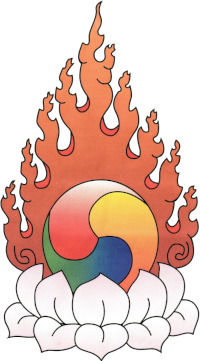GREEN TARA: 2013 FALL RETREAT
In this series, you will be listening to lightly edited audio teachings by Gelek Rimpoche during the 2013 Jewel Heart Fall Retreat held Friday, October 11 through Monday, October 14 at Garrison Institute, in Garrison, New York.
During the opening session of this retreat, Rimpoche delighted his audience when he announced the subject of the retreat would be the Green Tara practice. The attendees had come to this weekend eager to receive whatever teaching Rimpoche would offer and this, as it turned out, was a very special opportunity.
Brief descriptions for each of the 19 sessions follow.
Session 1
Rimpoche introduces Tara, specifically the 21 Praises of Green Tara, as a time-honored practice relied on by ordained and lay people alike. Always a first step, we reflect on our motivation for engaging this practice. If our goal is total enlightenment or Buddhahood, then Buddhism can deliver the goods. While it may be possible to achieve the ultimate goal outside of Buddha’s teachings, Buddhadharma provides targeted antidotes for removing our samsaric obstacles.
Session 2
Buddhism is practical. Our dharma practice, based on the reliable experiential teaching lineage of great masters, guides us gradually to our goal – enlightenment’s total knowledge. With this base, we have a point of reference to assess our progress. Within our practice, we learn, think and then meditate through active, analytical meditation. This process impacts our character, our way of living and functioning, and ultimately, our destiny.
Session 3
Responding to a question about Tara and feminine power, Rimpoche answers that it is a comfortable energy, kind, forgiving and quick to function. For Buddhists, Tara is a female Buddha. When global religious/cultural curtains are lifted, we find her manifestations revered around the world, answering the calls of all in need of her assistance or protection.
Session 4
When we ask “How do I to achieve this?”, we are told to tame our mind, to look inward. We tend to see others’ faults, not our own. Dharma is like a mirror that reflects how we really are, positive and negative. When we watch our mind, we can see how we hold to “me” and “mine” as the priority – we discover our obstacle to developing love and compassion. To recognize this, to think and meditate upon it, is important and helpful.
Session 5
We pray to Tara, female manifestation of the Buddha of Compassion, Avalokiteshvara. In deepest reality they are the same: Tara is Buddha. Buddha is Tara, no separation. Ultimately, Buddhas, yidams, gurus are the same reality and it’s important to keep this in mind. Also, at the appearance level, enlightened beings function in specialized ways, sometimes wrathful, sometimes peaceful in nature. When we invoke Tara, she is already continuously, pervasively there.
Session 6
Green Tara resides in the turquoise-colored pure land of Yulod Kurpa. Her seed syllable, TAM, includes the letter “AH”, the life of all sound. Mantra is nothing but sound; it is not the written script. The essence of energy is sound and the base of sound is air, strongest of the five elements. As a seed syllable, the sound TAM is the real source of energy and power. To understand sound and energy as separate is a mistake.
Session 7
Tara is defined in the invocation verse of the Tara Prayers as “action mother”, indicating her role as a fully functioning Buddha – helping, protecting and healing beings both directly and behind the scenes. Prostration follows invocation, reflecting not only our profound respect and admiration for Tara and her extraordinary qualities but also our deep wish to acquire these qualities for ourselves.
Session 8
The main purpose of the Seven Limb activities is to help the individual practitioner improve. The first limb of prostration involves recognizing Tara’s enlightened qualities with a heartfelt wish to acquire the same qualities ourselves. We do this with a pure mind free from attachment. With the next limb we make physical and mental offerings, acknowledging to ourselves that the enlightened beings have happily accepted our offering – a karmic benefit for us.
Session 9
Understanding our past negative actions will lead to our future experience of negative results, the third limb of purification has the power to nip in the bud effects that have not yet ripened. Purification, acting at a causal level, may avert or ameliorate our future suffering that would otherwise naturally arise from our non-virtuous actions. For purification to succeed, we must sincerely apply four opponent powers, particularly, having strong regret for our actions.
Session 10
Rejoicing, the fourth limb, is an easy way to accumulate good karma. When we rejoice in the dharma activities of ourselves and others, we receive karmic benefit. Rejoicing is the opposite of jealousy, an ego-based emotion. Rejoicing is an altruistic-based emotion. As Rimpoche quips, “Rejoicing is an investment without risk.”
Session 11
The next limb of requesting teachings, recognizes we need teachings – teachings suitable for our level of mind. At times we need fundamental teachings of morality, concentration and wisdom, common to the Theravada perspective. At times we need teachings on the six perfections, on love/compassion and bodhimind from the Mahayana scope. And other times we may need Vajrayana teachings. Experiencing this limb also reminds us of the continuing need to connect our everyday mind with the dharma so that dharma becomes part of our character and destiny.
Session 12
The final two limbs are requesting for the buddhas and dharma to remain until samsara is empty, and for the dedication of our merit to become the cause of enlightenment for the liberation of all beings. The Seven Limbs, Rimpoche says, are a simple essential practice of Buddhadharma, a service to ourselves on the path to enlightenment.
Session 13
The final two limbs are requesting for the buddhas and dharma to remain until samsara is empty, and for the dedication of our merit to become the cause of enlightenment for the liberation of all beings. The Seven Limbs, Rimpoche says, are a simple essential practice of Buddhadharma, a service to ourselves on the path to enlightenment.
Session 14
Rimpoche notes three basic ways to praise Tara: 1) from the historical perspective; 2) Tara’s physical attributes; and 3) her activities, highlighting the extraordinary qualities of one who has gone beyond samsara and nirvana. Tara’s name in Tibetan means liberator, one who responds with extraordinary speed and power to destroy evil forces and to liberate sentient beings. Her wisdom eyes see everything immediately and simultaneously — with total knowledge.
Session 15
Tara’s face is like 100 autumn moons. After the dust of summer, autumn is a pristine time of year in Tibet, and Tara’s appearance embodies beautiful, crisp clarity. One hand gestures an invitation to join with her. The other hand indicates, “I will protect you.” Tara’s invitation is for everyone, especially for those who are fearful, downtrodden, without hope.
Session 16
Tara’s capability and power have grown out of the six perfections: generosity, morality, patience, joyful striving, concentration and wisdom. All Buddhas have Tara at their crown, a sign of victory over negativities. The letter HUM at Tara’s heart emits liberating sound/energy together with her mantra, filling up the seven samsaric realms of gods, human beings, animals, hungry ghosts, hells, form and formless space; destroying all negative powers and healing all realms with her transformative light, overlooking no one.
Session 17
Following recitation of the 21 Praises and Benefits and a brief review of earlier sessions, Rimpoche examines the more wrathful aspects of Tara. The roaring sound of “TURE” with a slightly wrathful hand gesture overpowers all evils including those most difficult to tame — our own negative emotions. These include direct afflictive emotions as well as deeply embedded negative karmic imprints, serious obstacles to total enlightenment.
Session 18
The continuing homage verses describe the various aspects of Tara’s appearance and activities — hand mudra, radiant crown, pure laughter, peaceful and wrathful facial expression, earth-pounding feet, garland of flames, vibrant HUM at heart level, etc. — focusing on defeating both external and internal enemies.
Session 19
Wrapping up the retreat, Rimpoche provides brief commentaries on the final homage verses, which describe Tara’s ability to bestow liberation, dispel all poisons, soothe quarrels and nightmares, quell epidemics and crush the masses of evil influences.
Become a Subscriber:
To become a Digital Dharma On Demand Subscriber and enjoy this and many other teachings, please visit:
https://www.jewelheart.org/on-demand-subscription/


